Goat pregnancy care is on our minds these days because it’s obvious that several of our Dwarf Nigerian does are pregnant (see the Kidding Schedule for delivery dates this year). But, 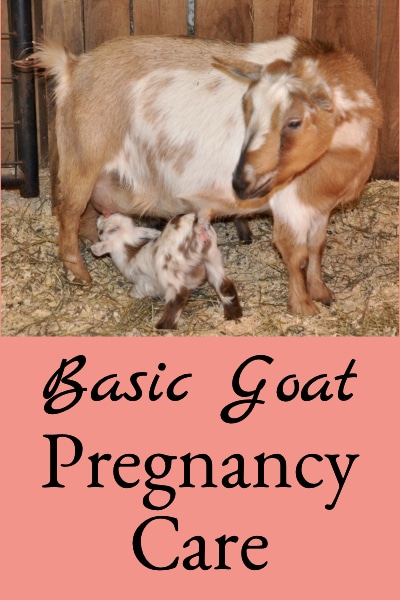
we carefully considered their maturity and needs during pregnancy before taking this step.
Basically, there are three stages of goat pregnancy care to consider: 1) breeding, 2) early gestation, and 3) late gestation. At each of these stages, there is a preferred Body Condition Score ([BCS] see Body Condition Scoring for Goats) that should be maintained, specific feeding guidelines, and preventative vaccinations/health precautions that are recommended.
1) Breeding
Before breeding, it’s typically recommended that first freshening does be at least 65% of their adult weight, that does BCS be at 2.5 to 3.0, that they are dewormed (if necessary), and that they receive a BoSe (Selenium + Vitamin E) shot if they’re located in areas of the country where Selenium deficiency is a problem.
For Nigerian Dwarf does, 75 lbs. is considered an average weight so first freshening does should be about 50 lbs. Often, the doelings born last spring are too small to breed in the fall, so we generally wait until later before breeding the first time.
Feeding a grain concentrate starting 2 weeks prior to breeding (and continuing for about two weeks after (referred to as flushing)) is suggested to get thin does body weight up (you want a BCS of 2.5 – 3.0); however, this wasn’t necessary in our case because the does we planned to breed were getting grain twice a day already (since we were still milking them).
Normal feeding at this stage should consist of pasture, hay (save your best hay for early lactation), and free choice goat mineral containing 16% calcium and 8 % phosphorus (it’s important to maintain the calcium to phosphorus ratio at 2:1 to make sure they’re getting enough calcium). If milking, a grain ration should also be fed twice daily.
It’s also beneficial to deworm a couple of weeks prior to breeding if analysis indicates it’s needed – growing kids are enough work, the does don’t need to be dealing with a heavy worm infestation too. We deworm with Ivomec 1% injectable approximately 2 weeks prior to breeding. We also give each doe a BoSe injection prior to breeding since our area of the country is Selenium deficient (the vitamin E helps them absorb the selenium so it can be used).
2) Early Gestation (up until last 6 weeks prior to kidding)
The average miniature goat gestation period is 145 days (there is a goat gestation calculator HERE) and the first 3 ½ months are considered the early gestation period. During this time, the embryo(s) grow slowly, and there are usually few observable changes in a doe. BCS should be maintained at 2.5 – 3.0, and it’s important not to stress the doe (now is not the time to bring in new goats, a dog, etc.).
If stressed, a doe at this stage is capable of reabsorbing the embryo – obviously not a desirable outcome. Feeding should consist of medium quality hay, good pasture, and free choice goat mineral – they don’t need grain at this stage if they’re not being milked.
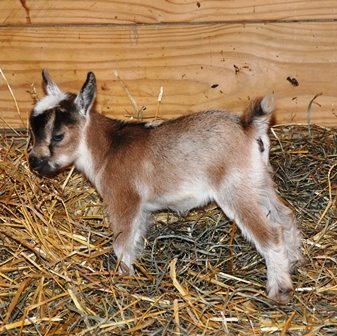
Since we were milking, ours got grain twice daily but we slowly decreased this to a very small portion once daily as we dried them off (quit milking). It’s recommended that goats in milk be dried off at least two months before kidding. The small grain portion encourages them onto the goat stanchion for a checkup and a little grooming each day.
Drugs should not be given to goats during the first 25 – 30 days of pregnancy, the fetal cells divide rapidly during this period and introducing drugs at this time can cause birth defects.
3) Late Gestation (last 6 weeks)
During the last 6 weeks, kid fetal growth increases exponentially, so nutrition should increase to bring the BCS up to 3.5 – 4.0. To do this, feed should consist of pasture, medium to good hay (orchard grass + legume), free-choice mineral, and a grain concentrate gradually needs to be added.
For the grain concentrate, a 15% protein goat pellet is recommended and at this point, the doe needs to start eating for at least two (herself plus however many kids). Exactly how much grain concentrate and how quickly to increase the ration needs to be tailored to each doe – does feeding multiples need more concentrate, but the kids shouldn’t get too big or kidding will be difficult.
It’s also important during this period to watch the goats daily, if their BCS isn’t adequate they can go into ketosis, pregnancy toxemia, or hypocalcemia quickly. For these conditions, having molasses and propylene glycol on hand is critical, but a Vet will also likely be necessary.
At four weeks prior to kidding, it’s recommended that the does be vaccinated with CD&T, given BoSe (in areas with Selenium deficiency), and some breeders vaccinate or treat to prevent abortions. The CD&T vaccination ensures that the kids will have tetanus immunity (through the colostrum they receive after birth) and the BoSe prevents white muscle disease in kids. Vaccinating or treating to prevent abortions is dependent on the condition causing the abortions and needs to be coordinated with a veterinarian.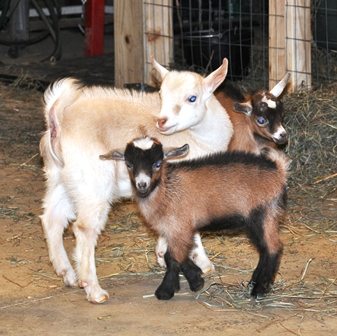
At one week prior to kidding, it’s often recommended that the does be de-wormed again. Worm loads tend to increase rapidly in does just prior to kidding, so deworming just before kidding can minimize parasite problems for both the does and kids.
The prospect of having milk and cute little kids bouncing around again this spring is very exciting, but also a little scary. Our does have become much more than just sources of brush control and milk – they’ve become loved pets. And since we don’t want them to suffer any harm, we’ll try to provide the best goat pregnancy care we know through the various stages of their pregnancies.
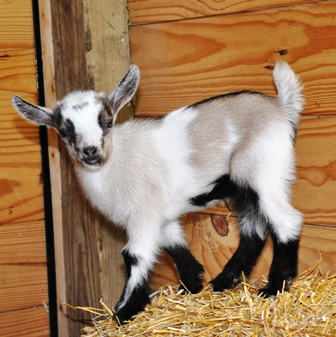
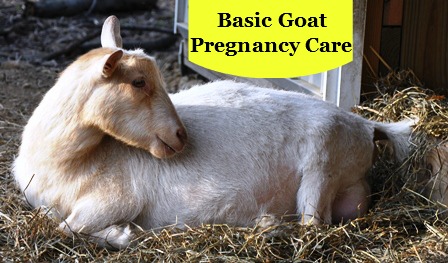
Karis Fisher says
What type of dewormer do you give your pregnant goat?
Lesa says
Hi Karis, we usually use Ivomec. Do NOT use Valbazen on a pregnant goat.
Carolyn Hammack says
Do you have an experience with Replamin Gel Plus? It has copper, selenium, and Vit E as well as other vit. and minerals. I have read that it can be used instead of BoSe or Copper bolus. It is sold by Jeffers Vet Supply in Dothan,Al
2. Some in our area are using Selenium and Vit. E from Jeffers during pregnancy instead of the BoSe? Any comments on these 2 questions would be appreciated. thanks
Lesa says
Hi Carolyn, I don’t have experience with Replamin Gel Plus or the Selenium and Vit. E from Jeffers. You might try joining this Facebook group and try asking the same questions – I think I’ve seen it come up there before: Successful Goating with Rosie (https://www.facebook.com/groups/1084839991610657/)
Grace says
Reading through your article I wanted to be clear I understand. If living in a selenium deficient area ( I’m in Central IL) you give the does a BoSe shot prior to breeding and then a second shot during their last 4 weeks of gestation?
Lesa says
Hi Grace, yes you read it correctly, I give them BoSe prior to breeding and again 4 weeks before freshening 🙂
Ellen Long says
I just located your article on “Basic Goat Pregnancy Care” Very interesting. And Thank You.
I purchased a nigerias 8mo Doe and a wether about 10 weeks ago. Now I am realizing that this young doe is actually pregnant. The baby movements are very obvious in her right abdomen. I have felt the babies head and feet moving. I have got a lotof catching up to do. I have been researching goats. I have no idea when her gestation took place nor what she was bred to. On 05/03/18 I saw some mucus string from her vulva. She has been growig an udder. She came to me with no udder so I thought she was just developing as normal. She has had no preparation for kidding. Any advice for me?
Lesa says
Hi Ellen, I would definitely contact the previous owners and at least find out what she may have been bred to and if they can give you a date. Hopefully, she was bred to an ND so you don’t have to be concerned about really, really huge babies but she’s still quite young so it may still be a problem. You didn’t mention how much she weighs herself – if she’s tiny then you’ve got more to worry about than if she’s a big girl. If you can’t find out what she was bred to and when, then I would take her to your Vet and have them help you determine the best course of action, otherwise you’re just playing a guessing game and hoping for the best.
Maria Vargas says
Hello Lessa,
Thanks so much for such a detailed article, it will help us a lot, since we are new to hosts. One quick question, what kind of grain concentrate do you use?
Lesa says
Hi Maria,
We use Kalmbach Game Plan All Natural Milk & Meat Pellet, the link to Kalmbach’s page is here: https://www.kalmbachfeeds.com/products/game-plan-all-natural-milk-meat-pellet You used to be able to get to the ingredients list from their site but I’m not seeing how to do that today.
Nancy Wagner says
Lesa, I have four Nigerian/Pygmy crosses and believe all four are bred and due in late March/early April. This morning my queen started attacking the youngest doe and I found the “victim” quivering in a corner of the barn. I checked back in an hour to see if it was just a one time thing but she was still hiding and quivering. I’m wondering if I should isolate the queen or the victim or just let them figure it out. That said, I am afraid the battering could harm the unborn kid or kids.
Lesa says
Hi Nancy, yes it happens that the queens can get what seems to us as “overprotective” and appear to harass the does that are lowest on the pecking order. And yes, they can do damage to the unborn kids. Since you have four, is it possible to separate them into two groups, the queen with the next strongest doe, and then the youngest with the third doe on the pecking order? I really hate to isolate anyone, so try to arrange things so everyone is housed with a “buddy” until it’s time for them to go into a birthing stall by themselves.
Guinevere McIntyre says
Lesa, I am the editor for the Iowa Dairy Goat Association newsletter. I would love to reprint this article (Basic Goat Pregnancy Care) in our upcoming newsletter, coming rather soon in late October. May I have your permission to do so, and if so, please let me know exactly how you would like to to list you for credit. Thanks!
Lesa says
Hi Guinevere, Yes you may reprint this, I hope it helps lots of pregnant does receive great care! For credit, “Lesa Wilke is a freelance writer and co-owner of Bramblestone Farm in northeastern Ohio, where she raises chickens, Nigerian Dwarf goats, honey bees, and natural produce. You can follow her farm exploits on her Better Hens and Gardens blog (www.betterhensandgardens.com)”.
Kym says
It’s really hard to find the kind of detailed information about goat care that you offer here. Even our 4h leader wasn’t as thorough. Our doe is due is 6 weeks and we keep coming back to your site. These will be first kids for us! Thk u!
Lesa says
So glad you find it helpful Kym, good luck on those first kids – they sure are fun to have around!
Carissa says
What kind of minerals do you feed?
Lesa says
Hi Carissa, We always used Manna Pro goat mineral, but recently were unable to get it and tried Purina, and the goats really seem to love it. I want to compare the % of what’s in each though before we would switch, the Manna Pro has done well for us, and although they seem to love it, I want to make sure the Purina is an equivalent.
Avi says
I believe manna is better for selenium & copper as our hay tends to be deficient …
Don’t you worry about the effect of dewormer drugs on the kids ?
Lesa says
Hi Avi, I like the Manna too and yes I’ve worried about the effect of the dewormer drugs on the kids, but have never experienced a problem so we continue to use the same practice.